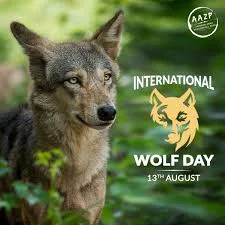The Importance of Wolves: A Keystone Species
Wolves, often misunderstood and maligned throughout history, are more than just majestic creatures of the wild. As apex predators and keystone species, they play a crucial role in maintaining the balance of ecosystems. On International Wolf Day, it's essential to acknowledge their significance and the far-reaching effects they have on the environments they inhabit.
Wolves as a Keystone Species
A keystone species is one whose presence and role within an ecosystem have a disproportionately large impact on the environment and the other species that inhabit it. Wolves fit this description perfectly. By controlling the population of prey species, they help prevent overgrazing, which in turn maintains the health and diversity of the plant and animal communities within their ecosystems.
Wolves affect various aspects of the environment:
1. Regulation of Prey Populations: Wolves primarily hunt large herbivores like deer, elk, and moose. By keeping these populations in check, they prevent overgrazing, allowing vegetation to thrive and promoting biodiversity.
2. Promotion of Healthy Prey Populations: Wolves tend to target the weak, sick, or old members of prey populations, leading to healthier and more resilient prey species over time.
3. Encouragement of Scavenger Species: Wolf kills provide food for a variety of scavengers, such as ravens, eagles, and bears, supporting a broader range of species within the ecosystem.
4. Impact on Trophic Cascades: The presence of wolves creates a ripple effect throughout the food web, influencing the behavior and populations of various species. This phenomenon is known as a trophic cascade, which can lead to profound changes in the ecosystem.
Case Study: The Yellowstone National Park
One of the most well-documented and celebrated examples of the wolf's role as a keystone species is the reintroduction of wolves to Yellowstone National Park in the United States.
Background:
Wolves were eradicated from Yellowstone in the 1920s due to human activities, primarily hunting and government-led extermination efforts. The absence of wolves led to significant ecological changes, most notably the overpopulation of elk, which resulted in overgrazing. The ecosystem began to deteriorate, with plant species like willows, aspens, and cottonwoods suffering greatly. This had cascading effects on other species, including beavers and songbirds, whose habitats were destroyed.
The Reintroduction:
In 1995, wolves were reintroduced to Yellowstone as part of a major conservation effort. The impact of their return was profound and immediate. With wolves back in the park, the behavior of the elk changed. They began to avoid certain areas where they were more vulnerable to predation, such as riverbanks and valleys. This allowed vegetation in these areas to recover.
As the vegetation thrived, beavers returned to build dams, creating habitats for fish, amphibians, and birds. The entire ecosystem began to regenerate, illustrating the power of the trophic cascade initiated by the presence of wolves.
The Broader Impact:
The Yellowstone example has become a cornerstone in conservation biology, demonstrating the importance of predators in maintaining the health and stability of ecosystems. It has inspired similar reintroduction efforts worldwide and has shifted public perception of wolves from that of fear and hostility to respect and appreciation.
Conclusion
Wolves are more than just symbols of wilderness; they are vital components of healthy ecosystems. Their role as keystone species underscores the importance of conserving and protecting them. As we celebrate International Wolf Day, let us remember the lessons from Yellowstone and work towards ensuring that wolves continue to roam wild landscapes, maintaining the natural balance that benefits us all.










Comments
Post a Comment